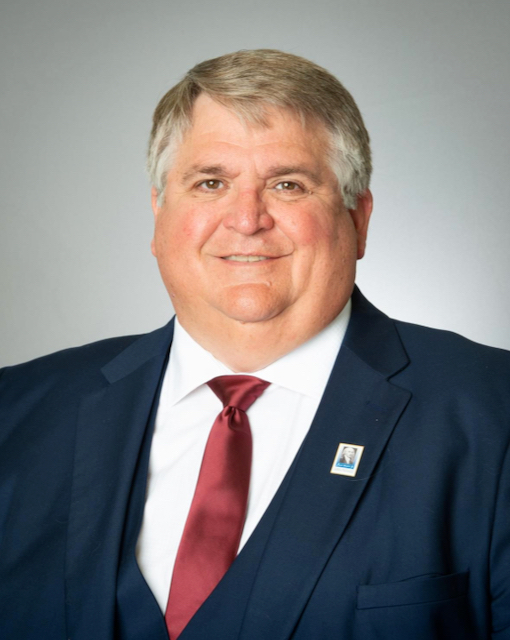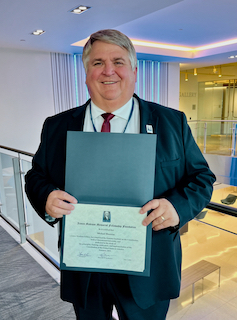Meet Our Teachers
Mike Bisenius

Mike Bisenius teaches Senior level US Government, Junior level US History, and Freshman World History at Red River High School in Grand Forks, North Dakota. A 2022 James Madison Fellow and graduate of the Master of Arts in History and Government program at Ashland University, Bisenius was named 2023 North Dakota History Teacher of the Year by the Gilder Lehrman Foundation. Below, Mike explains his teaching practice and how his study in MAHG improved it.
I first became aware of the Masters in American History and Government program (MAHG) program when I was selected in 2011 to participate in a three-week seminar called the Presidential Academy. It was phenomenal: teachers from around the country spent time in Philadelphia, Gettysburg, and Washington, DC visiting historic sites and studying three key moments in American history—the Founding, the Civil War, and the Civil Rights movement. It was there that I first read primary documents intensively and was encouraged to use them in my classroom.
How MAHG Study Changed My Teaching
When our school started offering dual enrollment courses, I needed either 18 credits or a Master’s in my subject area to teach in the program, so I investigated graduate options available locally. The University of North Dakota in Grand Forks had dropped their graduate program in history. For a while I drove 60 miles south after the school day to North Dakota State University in Fargo; but I ran into roadblocks there. Then I remembered that the organizers of the Presidential Academy spoke of their MAHG program. I applied for a Madison Fellowship to help fund the cost of the program and fortunately was awarded it. Both the Madison Foundation Summer Institute in constitutional studies and the MAHG program are centered around primary documents.

My experience in the Presidential Academy prepared me for the fast-paced residence programs at MAHG and at the Madison Summer Institute in Georgetown. In all of them, I did a lot of reading ahead of time. In MAHG, every class period is a discussion, which is great; in the Madison program you have morning lectures and one afternoon discussion period. During the few hours between class sessions, all the teachers form study groups. Before attending the Madison Institute, I did my summer residency in MAHG, where I met some really great teachers from around in the country. A teacher from Seattle, another from West Virginia and I became close; we formed a study group that continued when we all went to Georgetown. It really helped us prepare to discuss the readings and even to work through the arguments of our essay assignments.
As I earned my MAHG degree, I shifted to teaching more often with primary documents, and it has helped bring depth to my classes. It’s also given me confidence amid the accusations of parent groups in our state who say teachers indoctrinate students. If I’m accused of misrepresenting Jefferson, I can reply, “But how better can I teach Jefferson than to ask students to read his own words?” Some students need help reading the documents. I have to carefully choose the excerpts I use. But some documents are so powerful the kids cannot miss the point. Frederick Douglass, for example. He’s phenomenal.
History Causes Us to Ask: What Was the Right Choice?
I don’t sugarcoat American history. I tell students that I teach the good, the bad, and the ugly. History study should be uncomfortable. If you’re too comfortable, you’re not studying it very well.
According to our state standards, high school American history begins with Reconstruction. But none of us at my high school start there. I cover the antebellum period in a day and then do a unit on the Civil War. How can you understand Reconstruction if you don’t remember from your middle school history class how and why that war happened? My assessment for the unit is a project students complete in three stages. There are thirty options for independent work; students choose four increasingly complex assignments. For example, students may make a chronology of the war, complete with documents and pictures; they may write a research paper; they may memorize and recite a short speech, such as the Gettysburg Address or an excerpt of Douglass’s “What to the Slave is the Fourth of July?” Students choose the projects that play to their strengths, and everyone learns.
In discussions with students, I often play devil’s advocate, which drives the students nuts. They think they’re on my side, and then I hit them with questions from the other side. I may agree with them, but I like to get them to defend their position. When we study World War II, we always debate the question, “Should Truman have dropped the bomb?” Now that documents of that era are bring declassified, I’m starting to read them. I plan to assign students two document excerpts in favor of dropping the bomb and two against, and then to have them debate the question.
What I’ve Learned From Immigrant Students
Because of a refugee resettlement program in our community, our students are aware of the world outside of North Dakota. A number of my students immigrated here with their families from places like Syria, Iraq, Iran, Afghanistan, Nepal, and Somalia. I ask them about their experiences; it helps to put American history and government into perspective for everyone in the class. At one time, I taught a class for English Language Learners (ELL) only. I tried to get their parents involved—I would tell students, on the first day of class: “Ask your parents to describe what government was like in the country you came from. How did the laws work there?” Many came back to class reporting that their parents fled their countries for religious reasons. For example, students from Nepal or Bhutan explained that their families had been promised religious tolerance by the government, then a new government took over and withdrew that tolerance. Other students’ families had gotten caught in the crossfire of tribal wars, because they belonged to neither side of the conflict.
Occasionally, if I stepped out of my classroom between periods, a fight would break out. Once I entered the room to find a tiny girl lifting her desk, preparing to hurl it at a boy. She had already thrown her shoes and books at him. I don’t know what he’d said to her, but I knew some of my students had grown up in refugee camps where boys had learned not to respect women. This girl probably had been abused. All the students were yelling, in their own languages, and I had no idea what anyone was saying. So, I began yelling at them in the bit of Norwegian I’d learned from my immigrant grandmother. Suddenly they stopped and looked at me, like, “What are you doing, Mr. Bisenius?” I said, “Well, I got your attention.” I sent the boy to the principal’s office and the girl to an ELL room where there were teachers who knew her well and could help her calm down, and then class began.
One of the first questions I ask my immigrant students is, “Do you plan to become a citizen?” Most do, but I’ve been surprised that a fair number—often the Somalis and Ethiopians—hope to return to their own countries. If I know I have students who plan to take the citizenship test, I can better focus my lessons to help them with that. Of course, all the students need to know basic civics facts; in North Dakota, you must pass a test very like the citizenship test in order to graduate.
What I Hope My Students Learn
In my government classes, I always challenge students. I give them the statistics on voter turnout for the various age groups. People between the ages of 18 and 29 have the lowest turnout and those over 65 the highest. I ask them why older people vote so regularly. They talk about it and conclude that older people vote for candidates pledged to preserve Social Security, Medicare, and Medicaid. I ask them, “What does your age group care about?” They mention college and textbook costs. So, I tell them, “Your age group has the potential to be a massive change agent. Organize, find a candidate who will fight for you, and then work to get him in.” I don’t tell them how to do that; that’s up to them.
I hope they leave my classroom unafraid to ask questions—especially to ask, “Why?”—the question I so often ask when they state their opinions. I hope they will question what they hear. On the first day of class, I tell students, “I double dog dare you, I triple dog dare you, quadruple dog dare ya—Try to stump me. Find a mistake that I’ve made. Now, the catch is that you have to do some research so you can prove it. I’m going off of many years of reading, researching, talking to knowledgeable people. I think what I’m telling you is the truth. But if you think I’m wrong, and can back it up with proof, challenge me.”
Once while we were studying World War II, I said the Germans had built the first jet. A kid challenged me: “No, I think it was the British who did that.” I said, “Prove me wrong.” The next day he comes in with an article stating that the British had built a jet about six to eight months before the Germans. I said, “Okay. I stand corrected.” Last year I had a senior who argued with me about everything. In one of our best arguments, we actually agreed with each other, but we still argued. Later I told him my respect for him really grew when I saw he was unafraid to challenge me. For the first time all semester, the kid smiled. I don’t know where he is now, but I hope he’s doing well.
Kids may get frustrated when I ask them “Why?”— but later, they appreciate it. A few years back, my family and I were out eating supper. Although I didn’t see him, a former student saw me in the restaurant and paid for our dinner. I wish I knew who that student was; I would love to thank him.
